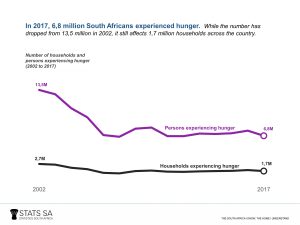The Extent of Food Security in South Africa
Did you know that in 2017, 6,8 million South Africans experienced hunger? While the number has dropped from 13,5 million in 2002, it still affects 1,7 million households across the country. These figures were released in a recent survey, “Towards measuring the extent of food security in South Africa: An examination of hunger and food inadequacy”, published by Statistics South Africa (Stats SA).
Whilst South Africa is food secure at national level, the country is still food insecure at household level as not all households have access to adequate food. Almost 20% of South African households had inadequate or severe inadequate access to food in 2017. This varied by province, population group of household head and by household size.
According to Oxfam, food security occurs when all people at all times have access to sufficient, safe, nutritious food to meet their dietary needs for an active and healthy lifestyle. Food insecurity occurs when people’s access to food is minimally adequate and they have trouble meeting their basic needs, while severe inadequate access to food occurs when there is a critical lack of access to food.1
Limpopo (93,6%) and Gauteng (84,0%) had the highest proportion of households that reported adequate food access whilst North West (64,0%) and Northern Cape (66,5%) provinces had the lowest proportions of households that had adequate food access and therefore can be seen as the least food secure.
Households headed by black Africans and coloureds were less likely to have adequate access to food compared to households headed by Indians/Asians and whites. In addition, households with larger household sizes were more likely to have inadequate or severe inadequate access to food compared to those with smaller household sizes. Almost two-thirds of the households that were vulnerable to hunger resided in urban areas.
Food inadequacy and hunger are still a challenge. Poverty-stricken households lack money to buy food and are unable to produce their own food. These households are constrained by the inability to secure employment or to generate income. Poor households are also typically characterised by few income-earners and many dependents, and are particularly vulnerable to economic shocks.
Severe inadequate access to food is mostly found among households with more than eight household members. According to the report, just under a third (29,6%) of households that comprised more than three children reported that food access was inadequate. This proportion is almost twice the national average. Households with no children or fewer children were more likely to have adequate access to food than those with many children.
Child hunger was still a challenge in South Africa. More than half a million households with children aged five years or younger experienced hunger in 2017. Northern Cape and KwaZulu-Natal had the highest proportion of households that experienced hunger. According to the report, more than half of households with young children that experienced hunger were in urban areas.
The involvement of households in agricultural activities for subsistence farming can play an important role in reducing the vulnerability to hunger of rural and urban food-insecure households. The results show that out of 16,2 million households, about 2,5 million households (15,6%) were involved in agricultural activities in South Africa in 2017. Provinces that are predominantly rural and with high levels of poverty such as Limpopo (25%), Eastern Cape (20%) and KwaZulu-Natal (20%) had the highest proportions of households that relied on agricultural activities to supply their own food. Most households involved in agricultural activities were involved in the production of fruits and vegetables, grain and other food crops, as well as in livestock and poultry farming. Although the main source of income for these households was social grants, most households involved in agricultural activities indicated that the main reason for their involvement is to supplement food for the household.
While food inadequacy and hunger remain a challenge, South Africa has made significant progress towards reducing the number of South Africans and the proportion of households who experienced hunger in 2002.
For more information on food security in South Africa, download the full report here.
1 https://www.oxfam.org/en/food-insecurity-infographic


